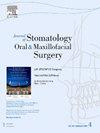Buccal pad of fat, advanced platelet-rich fibrin, fibrin glue, and oxidized cellulose plug in the management of oroantral communication: A comparative clinical study
IF 2
3区 医学
Q2 DENTISTRY, ORAL SURGERY & MEDICINE
Journal of Stomatology Oral and Maxillofacial Surgery
Pub Date : 2025-10-01
DOI:10.1016/j.jormas.2025.102376
引用次数: 0
Abstract
Oroantral communication (OAC) is a significant complication following the removal of maxillary posterior teeth that is a consequence of them being close to the maxillary sinus floor. The current study evaluated the efficacy of four treatment modalities for OAC management: buccal fat pads (BFPs), advanced platelet-rich fibrin (A-PRF), fibrin glue, and oxidized regenerated cellulose plugs. Twenty-four patients with OAC were randomly assigned to four treatment groups (n = 6 each) and clinically assessed for facial swelling, healing outcomes, and patient-reported pain at baseline, on day 3, and at weekly intervals for 4 weeks after their respective treatments. A linear mixed-effects model found a significant reduction in pain over time in all groups. Intergroup and intragroup comparisons of postoperative pain showed statistically significant differences between the groups at baseline and after 1 week. The BFP group had the highest scores for initial pain, while the A-PRF group had the least, with a consistent reduction throughout the study. The BFP group displayed significantly increased facial swelling on day 3, which had subsided after 2 weeks; the fibrin glue group followed a similar pattern but stabilized quickly. The A-PRF group showed minimal swelling and rapid tissue regeneration, while the oxidized regenerated cellulose group displayed less responsiveness for larger OACs. The choice of therapeutic technique for managing OACs should therefore be chosen according to the defect size and anatomical considerations. While BFP and fibrin glue were more efficacious for larger defects, the A-PRF technique showed rapid healing and less discomfort.
口腔脂肪垫、高级富血小板纤维蛋白、纤维蛋白胶和氧化纤维素塞在口窦交通管理中的比较临床研究。
由于上颌后牙离上颌窦底较近,因此在拔除上颌后牙后,出现了严重的口中通(OAC)并发症。目前的研究评估了四种治疗OAC的方法的疗效:颊脂肪垫(BFPs)、高级富血小板纤维蛋白(A-PRF)、纤维蛋白胶和氧化再生纤维素塞。24例OAC患者被随机分配到4个治疗组(每组n = 6),并在各自治疗后的基线、第3天和每周间隔4周对面部肿胀、愈合结果和患者报告的疼痛进行临床评估。线性混合效应模型发现,随着时间的推移,所有组的疼痛都显著减轻。组间和组内比较,术后疼痛在基线和1周后组间差异有统计学意义。BFP组在初始疼痛方面得分最高,而a - prf组得分最低,在整个研究过程中持续减少。BFP组第3天面部肿胀明显增加,2周后消退;纤维蛋白胶组遵循类似的模式,但很快稳定下来。A-PRF组表现出最小的肿胀和快速的组织再生,而氧化再生纤维素组对较大的oac表现出较低的反应性。因此,治疗oac的治疗技术的选择应根据缺损的大小和解剖考虑来选择。虽然BFP和纤维蛋白胶对较大的缺陷更有效,但A-PRF技术具有快速愈合和较少不适的特点。
本文章由计算机程序翻译,如有差异,请以英文原文为准。
求助全文
约1分钟内获得全文
求助全文
来源期刊

Journal of Stomatology Oral and Maxillofacial Surgery
Surgery, Dentistry, Oral Surgery and Medicine, Otorhinolaryngology and Facial Plastic Surgery
CiteScore
2.30
自引率
9.10%
发文量
0
审稿时长
23 days
 求助内容:
求助内容: 应助结果提醒方式:
应助结果提醒方式:


